INSIGHTS

Ryan Hale
Founder + Vice President - LaneshiftWhile it is no secret that walkable and bikeable communities enjoy a higher quality of life and stronger economic development opportunities, many city leaders struggle with knowing where to begin. Active transportation networks can seem like an amenity that is nice to have but ultimately feel unrealistic for some communities. City leaders often ask me, “Is this even possible in our town?” The short answer is yes.
I learned the power of practice early in my football career at the University of Arkansas. Like any team, we would watch film and review game plans in a classroom setting. It was an essential part of our success. However, it was no substitute for getting on the field and practicing together. The most impactful learning happened after we put on a helmet and pads and practiced at full speed. The importance of hands-on learning has stuck with me throughout my life and is especially relevant in my role leading Laneshift as an educator and facilitator.
At Laneshift, we host active transportation educational workshops built on the idea that the best way to learn is by doing. Our flagship program is called the Active Transportation Academy. It is a four-day professional development course that puts mayors, city engineers, city planners and other industry professionals on e-bikes so they can experience firsthand what it feels like to move around a city on a bicycle. We evaluate safety, comfort and motorist behavior in real time on two wheels. Through our work, one of the most powerful lessons we have learned is that if you can change the way people think, you can change the way people make decisions.
We have seen various city leaders experience an “aha” moment while participating in our educational programs. Through hands-on learning, they start to understand how harnessing a community’s culture — its behaviors and values — is both a powerful and necessary force for change.
“The academy completely transformed my perception of active transportation and how I interact with not only the physical spaces themselves but the people who are in positions to make positive impacts,” said Jennifer Grisson, former director of Fort Worth Bike Sharing.

No matter a city’s size, current budget limitations or political environment, there are steps any community can take to make active transportation more viable. The very first step to creating a connected community is learning and understanding the necessary ingredients. At Laneshift, we believe the ingredients of connected communities fall under two categories: infrastructure and culture.
We created the Connected Community Model to spell out these two components. Infrastructure is our built environment: We need our active transportation infrastructure to be safe, comfortable and connected. Culture is our behavior and values: We need our culture surrounding active transportation to be welcoming, accessible and encouraging. The marriage of infrastructure and culture is our recipe for creating a connected community.
For a city looking to embrace active transportation, creating a citywide bicycle and pedestrian master plan, researching available grants or even improving a crosswalk are all worthwhile endeavors. While these projects focus primarily on infrastructure and how to build it, there are equally important culture-building initiatives a city should also consider.
The city of Benton started a Ride with the Mayor event in which the public is encouraged to go on a leisurely ride through the city with Mayor Tom Farmer. The Square 2 Square bike ride from Bentonville to Fayetteville saw nearly 2,000 riders this spring and is open to users of all ages and abilities. Frequent pit stop locations along the route are filled with families and encourage riders to take it easy and enjoy the ride. Some school districts embrace Bike to School Week and provide adult-supervised group rides called Bike Trains to encourage independence and confidence among student riders.
At Laneshift, we are fortunate to host community leaders from across the country in our educational programs. Our participants often come away from our sessions with new determination and a new mindset on how they can apply what they learned in their own community. We often witness the very beginnings of a cultural shift happening at the personal level.
“The academy was an experience I could never compare to any other learning experience I have ever had,” said Gentry Mayor Kevin Johnston. “From the Laneshift team and their industry partners to the on-the-ground, see-it-for-yourself exposures, I returned to my community with a better understanding of how to see active transportation from many different angles.”
Why Environmental Due Diligence Is Key to Site Marketability

David Rupe
Vice President - EnvironmentalAttracting job-creating industries to invest in your community is hard work. It often requires years of planning, partnerships, and perseverance to outcompete the dozens of cities and states vying for the same investment opportunity.
One of the major selling points a community can offer a business looking to expand is a shovel-ready site. Environmental due diligence, along with transportation access, utility availability, and land use approvals are all key components of a site that’s ready for fast-track development. A shovel-ready site reduces risk and uncertainty for investors and can be the difference between getting short-listed for a job-creating project or missing the cut.
As an environmental scientist, my role in economic development projects is on the front end, most often as land is under consideration for potential investment. My advice for forward-thinking communities with a specific site they’d like to market is to undergo some basic environmental due diligence before having serious talks with prospective companies and site selectors.
Environmental due diligence is a relatively inexpensive investment that, when made early on, can make a site more attractive. It can lend credibility to the team offering the site and provide assurance that a potential large-scale project is viable.
 Environmental compliance may seem cumbersome at times, but each community is playing by the same rules, which exist to protect our health and preserve our natural resources.
Environmental compliance may seem cumbersome at times, but each community is playing by the same rules, which exist to protect our health and preserve our natural resources.
“We live and do business in the Natural State, and we want it to remain beautiful,” said Jeremy Biggs, vice president of economic development at the Rogers-Lowell Chamber. Biggs said anyone involved in the site selection process would benefit from having a basic understanding of the importance of environmental due diligence.
Here are three areas of environmental compliance that often intersect with economic development projects before breaking ground.
Wetland Delineations
A wetland delineation is a process used to identify and map where wetlands, streams, ponds, and other aquatic resources are located on a property. Environmental scientists visit the site to assess soil, water, and vegetation to determine if an area meets the criteria to be considered a wetland under federal or state regulations. If regulated by the U.S. Army Corps of Engineers, wetlands and other aquatic resources are protected, which means building on them may require Section 404 permits.
Phase 1 Environmental Site Assessment (ESA)
Phase 1 ESAs identify potential environmental contamination or hazards on a property before a transaction or development begins. Phase 1 ESAs consist of a review of historical property records, an on-site visual inspection for hazardous substances, discussions with property owners, and a regulatory compliance check.
National Environmental Policy Act (NEPA)
NEPA requires federal agencies to assess the environmental impacts of their actions before making decisions. If a project uses federal funds (including economic development grants), or in certain instances if there is a federal nexus, a NEPA review is required. NEPA reviews can take anywhere from a few months to two years and can require public comment.
Environmental compliance is complex and ever-changing. Before marketing land to potential industries, it’s important for community leaders to understand the potential delays environmental regulations can trigger if not addressed early. Environmental due diligence can help paint a clearer picture of the kinds of permitting — and the kind of timeline — a site or a particular project will require.
Dana Poindexter is the southwest Arkansas regional manager with the Arkansas Economic Development Commission (AEDC). She said the State of Arkansas recognizes the competitive advantage a shovel-ready site can offer when it comes to attracting new industries.
“Speed wins projects,” Poindexter said. “Any time you can show a company how quickly you can get them from spending money to making money, it is an advantage.”
The State, with the support of the Governor’s Office, allocated $10 million to launch the Site Development Grant Program in 2024. The program provides matching funds for site development improvement activities that will enhance industrial site readiness and competitiveness for certain projects. In its first year, the program received 28 requests totaling more than $44 million. The success of the program has allowed the AEDC to reopen these grants for the next two years with $25 million allocated each year.
Site due diligence study costs are eligible for grant funding, along with other site development-related projects like right-of-way acquisition and public infrastructure improvements.
“Site readiness isn’t just about land. It’s about speed, confidence, and removing risk for industry,” Poindexter said. “The communities doing the work now, including studies, permitting, and infrastructure, are the ones that are better positioned to get the visits later.”
Walkable Downtowns Drive Economic Development

Dave Roberts, PLA, ASLA
Senior Vice President - Planning & Business DevelopmentMany cities prioritize improving walkability in downtowns and commercial areas, not just to enhance safety or to develop community character, but because there is real potential for financial return on investment. Investments in walkability, which measures an area’s ease of connectivity via non-vehicular transportation, can include sidewalks, multi-use paths, streetscape enhancements, and traffic-calming measures. While these projects might be more often categorized as infrastructure, they do much more than provide a mode of transportation. They have the power to transform local economies.
Places where people feel safe and comfortable walking are places where businesses can thrive. Bustling downtown districts offer a variety of things to do - restaurants, coffee shops, art galleries, and breweries - all within walking distance of one another. Increased foot traffic creates higher property values in these areas and the surrounding neighborhoods as well. Over time, the tax value per acre in these dense, walkable areas will outpace areas that are more dependent on vehicular traffic. This has been confirmed in multiple studies by Urban3, a company specializing in revenue modeling and cost of service analysis for cities.
Not only do these compact, walkable places generate more tax revenue per acre, they require less extensive infrastructure networks compared to sprawling, car-dependent developments. For cities, this results in lower costs for road maintenance, utilities, and public services. It’s a win-win.